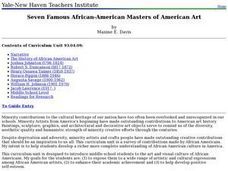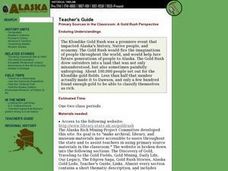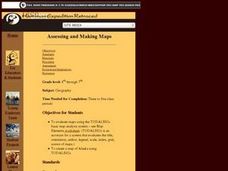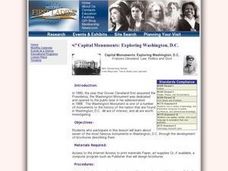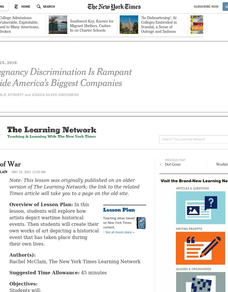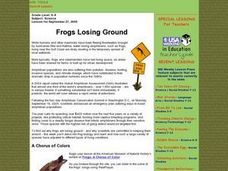PBS
Taking a Field Trip
Students examine the importance of taking a field trip. They make predictions and practice making environmentally sound decisions. They watch a video clip about enhancing historical experiences.
Curated OER
Seven Famous African-American Masters of American Art
Students examine seven different African-American artists. In groups, they use the internet to identify their contribution and techniques to the art world and examine the time period in which the artwork was produced. To end the...
Curated OER
Primary Sources in the Classroom: A Gold Rush Perspective
Students develop and hone their historical inquiry and analytical abilities. They draw up a list of 20 essential items they would have to bring to survive one year as a Gold Rush stampeder.
Curated OER
Learning About Location: Charting the Path of the George W. Elder
Young scholars acquire a working knowledge of the geographical concepts: absolute location, relative location, longitude and latitude. They analyze primary sources that shows the physical and human characteristics of the places along...
Curated OER
Assessing and Making Maps
Students evaluate maps using the TODALSIGs basic map analysis system, explained on the worksheet. They create a map of Alaska using TODALSIGs. Students brainstorm the elements of maps.
National First Ladies' Library
Capital Monuments: Exploring Washington, DC Frances Cleveland: Law, Politics and Government
Students, working in small groups, research seven of the most famous monuments found in Washington, DC. They design brochures based on the information they gather from Internet and print resources. Upon completion, they share the...
Curated OER
Messages in Art Work
Observe images and discuss what messages they convey. In this critical thinking lesson plan, learners determine whether works of art are trying to persuade their audience. They also consider the media and how they communicate messages to...
Curated OER
Charts, Maps, and Graphs Lesson on the Holocaust
High schoolers practice interpreting data. In this Holocaust instructional activity, students research selected Internet sources and examine charts, maps, and graphs regarding the Jewish populations in and out of Europe. High schoolers...
Curated OER
Where In the World Am I?
Learners identify their location in the world after studying latitude, longitude, relative location, and absolute location. They use assigned web site to find information to make a flipbook that answers questions about their location in...
Curated OER
Arquitectura
Third graders recognize that communities change over time. In this architecture lesson, 3rd graders discuss buildings in cities and compare to the buildings in Ancient Rome. Students explore the architecture and building of...
Curated OER
Case Studies of American Innovation
Studnets discover how the Industrial Revolution came to be in the United States. In this technological advancements lesson, students research creations by Henry Ford, the Wright Brothers, and Thomas Edison. Students create PowerPoint...
Curated OER
Native American Three Sisters Gardens
Students investigate companion planting. In this communtiy gardening lesson students explore the tradition of the Native American Three Sisters gardening approach. Students act as botanists, anthropologists, folklorists, and curators.
Curated OER
Freedom Summer
Students brainstorm and discuss what the concept of "fairness" is and how to identify examples of "fairness." They pull from historical fiction and the Civil Rights Movement to explain how individual are affected by, cope with, and...
Curated OER
Expository --Writing
In this writing worksheet, young scholars investigate the writing process, especially in expository articles. Students examine a piece written for a children's magazine about dinosaurs. Young scholars read about the steps taken to...
Curated OER
Masters of War
Young scholars explore how artists depict wartime historical events. Then students create their own works of art depicting a historical event that has taken place during their own lives. They create a classroom gallery.
Curated OER
Neoclassical Influences
Students study how artists of the Neoclassical period were influenced by major historical events during the Enlightenment. They identify and analyze the Neoclassical style. discuss and identify the historical influences of Neoclassical...
Curated OER
Goddesses Are Personifications Too!
Students explore the use of personification as a way of expressing ideals. They transfer this understanding to the present by creating an allegorical depiction of a contemporary ideal or value inspired by precedents in the...
Curated OER
A Dream Of Classic Perfection
Students examine primary sources in order to draw conclusions about the influence of Greek classical art and philosophy on the French Revolution. They compare the goals of the French Revolution to those of Neoclassical artists.
Curated OER
Urban Rocks: Investigating Stone Used for Buildings and Monuments
Students observe the rocks and stones used to build and carve monuments during a field trip.
Curated OER
The Perilous Fight: WWII - Up Close and Personal
High schoolers research World War II primary source documents and write first person historical point of view stories.
Curated OER
Making the Connection With Quilts
Fourth graders engage in a lesson which integrates the study of the Underground Railroad in Indiana with a Language Arts unit on quilts. They write a book report on one of the quilt books read in class and design a quilt block for the...
Curated OER
Did Rome Fall, Or Was It Pushed?
Seventh graders work in teams to research the reasons for the fall of Rome and come to a conclusion of why it did.
Curated OER
Frogs Losing Ground
Students explore an exhibit through an interactive program on frogs. They can listen to the different sounds frogs make and the different types of frogs. They search for the types of frogs they find in their local area.
Curated OER
Expedition Stories
Students use the Internet to research and discover information about expeditions that were formed to observe the transit of Venus. In groups, they work together to present information about the expeditions and create a visual aid.

